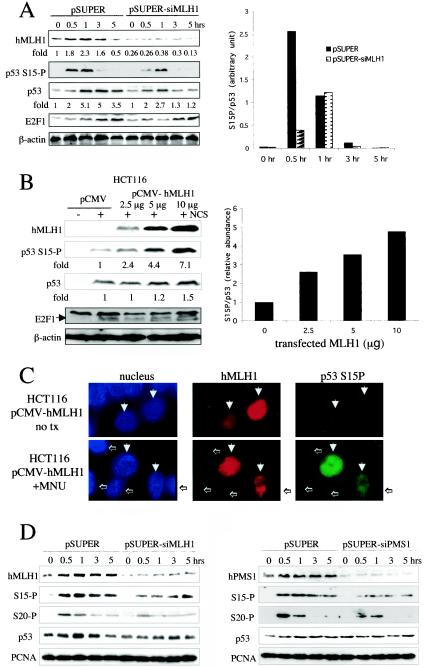FIG.9.
A role of hMLH1 and hPMS1 for p53 activation by DNA damage. (A) Inhibition of hMLH1 expression by siRNA blocked the induction of p53 but not of E2F1 in response to DNA damage. MCF-7 cells, stably transfected with hMLH1 siRNA or an empty vector, were treated with NCS (300 ng/ml) for 0.5 to 5 h. Western blot analysis was performed using antibodies as indicated (left panels). The intensity of the signals was quantified by densitometry. The relative levels of hMLH1 in pSUPER-siMLH1-transfected cells were compared to those in the untreated pSUPER-transfected cells. The ratio between the intensity reflecting Ser 15 phosphorylation and that of total p53 is shown in the right panel. (B) The extent of DNA damage-induced accumulation of p53, but not of E2F1, depends on the levels of hMLH1 protein. HCT116 cells were transfected with pCMV or increasing amounts of pCMV-SPORT6-hMLH1 as indicated on the top of the panels and treated with NCS (80 ng/ml) for 3 h (left panel). Cell lysates were subjected to Western blot analysis, and the intensity of the signals was quantified by densitometry. The ratio between Ser 15 phosphorylation and total p53 levels is shown in the right panels. The same results were also seen in the cells treated with NCS for 0.5 and 1 h. (C) HCT116 cells were transiently transfected with pCMV-SPORT6-hMLH1 and then left untreated (upper panels) or treated with MNU (lower panels) as described for panel B. Cells were fixed, and the immunostaining was performed with antibodies against hMLH1 (monoclonal) and phospho-Ser 15 p53 (polyclonal) followed by Texas Red X-conjugated anti-mouse IgG and fluorescein isothiocyanate-conjugated anti-rabbit IgG. Nuclei were stained with Hoechst 33258. The transfected cells expressing various levels of hMLH1 are indicated (↓). Cells which did not express hMLH1 are indicated (←). no tx, no MNU treatment. (D) HEK293 cells were transiently transfected with pSUPER, pSUPER-siMLH1, or pSUPER-siPMS1 and then treated with NCS (300 ng/ml) for 0.5 to 5 h. Western blot analysis was performed using antibodies as indicated.

